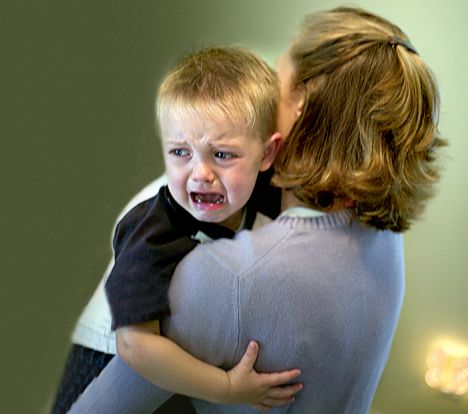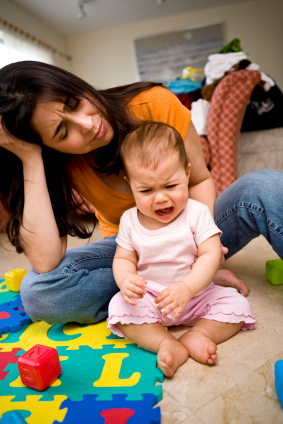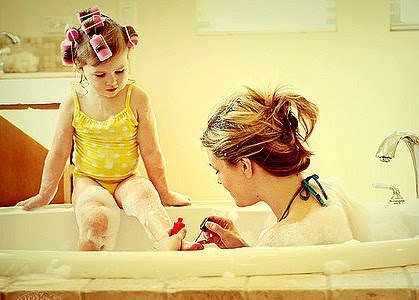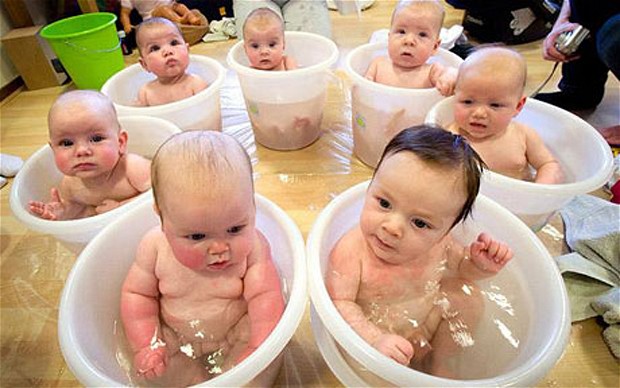One of the twentieth century’s most intriguing and dangerous fables insists that your children must be stimulated academically and socialized early. In order to do this, it says, you should toss them into the middle of preschool or get them involved with lots of their peers — the more the merrier. And it all seems so logical at first sight that you, as a concerned parent, can hardly wait to get them involved. Yet this is precisely the experience that most young children do not need. Little children are not little adults. They do not think, act, or react like adults. Their mental, emotional, and social processes are quite different.Although early academic stimulation has long been subject to serious question by child specialists, the socialization myth may in the long run be the greater threat. Little children are, of course, often highly stirred by a crowd of their peers, but at preschool age this excitement is more likely to confuse your youngsters than to make them truly sociable. And frequently it actually generates antisocial tendencies, making little rebels out of them, if not genuine neurotics. When this happens they reap the whirlwind in adolescence.
In 1902 the Ladies’ Home Journalpioneered a response-from-readers column — an idea now widely copied in the press. School entrance age had become an issue. And letter after parental letter cited physical and mental health problems created by early starts. One of them particularly noted an experiment by a number of parents. They found that when they invited 20 or 30 little ones to a birthday party, the children were too excited to sleep that night and were irritable the next day. When they invited only four or five, there were no problems.
Now nearly 75 years later, while circumstances have changed, the vulnerability of our children has not. There are many studies which suggest strongly that there is no security so great nor any socializing agency so positive and powerful as reasonably consistent parents in the climate of a warm and responsive home.
Child psychologists point out that children do very well when they can operate on a one-to-one basis or work in small groups of two or three or four. But strain often shows when they meet with classroom-size or larger groups for typical all-class activities.
As a parent, I should decide wisely what kind of social creature I want my child to be. Many preschoolers may indeed become “socialized,” but don’t be surprised if they develop a negativesociality. And this can happen even though the teacher or caregiver is an expert. On the other hand, if young children are given time to blossom naturally, they are more likely to develop into positive, altruistic social creatures.
The quality of a child’s sociality depends not so much on how many children he plays with as it does on his emotional stability, his sense of self-worth, and his unselfish concern for others. These usually reflect the quality of parental example and the strength of his attachment to warm and consistent parents.
One day recently two doting grandfathers in separate conversations insisted that their little grandsons were so bright and mature that they would not dare to deprive them of the “social advantage” of preschool. Dr. Harold McCurdy of the University of North Carolina studied the childhood patterns of 20 selected geniuses. He concluded that there were three factors which were common to these great men of history:
Seeking factors common to the early life of the twenty geniuses he selected, Dr. McCurdy came up with three: “(1) a high degree of attention focused upon the child by parents and other adults, expressed in intensive educational measures and, usually, abundant love; (2) isolation from other children, especially outside the family; (3) a rich efflorescence of phantasy, as a reaction to the two preceding conditions.”
Dr. McCurdy concluded that our educational system as it generally operates today has the effect of “reducing all three of the above factors to minimum values.” and, he believes, tends to suppress rather than encourage genius.
Building a Positive Sociability
Positive and negative sociability are not difficult to understand. Take the mother, for example, who brings her child into a home-making partnership. As far as the child is concerned they are “playing house” in the highest dimension. When the infant first begins to toddle, he can learn to put his toys away in a box in the corner. He can “help” make the beds by tugging on the spread or smoothing the sheets. He of course is not much help at first, but a little patience here will plant seeds of order, responsibility and industry, which with reasonably consistent cultivation will flower into self-reliance and altruism. A strong sense of self-worth thus developed is the essential basis for a truly stable, sociable child — or person of any age.By the time such a child is three of four, he is setting and clearing the table — counting out knives, forks, spoons and dishes, and learning further lessons in order as well as elementary arithmetic. He shortly can assist in doing dishes, counting eggs, measuring flour, quartering apples, and otherwise adding to his knowledge and skill. By the time he is eight or nine — which is more nearly the right time for most children to begin school — he is able to clean house, prepare and often even purchase food, do elementary ironing, sewing and be a strong help instead of a drag on his parents.This experience will be much more productive if daddy spends some time daily with the children — boys and girls. Toys they make, however simple, and things they do together — such as shining shoes, washing the car, weeding the garden or making a birdhouse — pay off handsomely in later mutuality, and avoid the rebellion which may often otherwise be expected. A small child finds a single piece of pointed board highly challenging to his imagination. It may be a boat or a car or a truck; or with a cross piece it may be an airplane. But the important factors are that (1) he and daddy or mother shared in its building and (2) that it, unlike most toys, leaves something to the imagination.
The creative spark abetted by parental fellowship — whether with mother or father — builds in children a desirable independence. As they share in the home duties and responsibilities they feel needed, wanted, and depended upon. These experiences are the bricks, mortar, and reinforcement of self-worth and a positive, altruistic sociability.
Some say this is fine for the suburbs or the country, but how about the city? And suppose he has no daddy? Remember that the children in the city schools generally are the product of their environment. Going to school does not make your children’s peers any better associates than those at your doorstep. Of course, if you trust the teacher’s supervision more than you do your own, your child may be better off. But remember that she normally cannot give such personal care as you can provide. And remember, too, for your young child under 7 or 8, your warm, consistent responses are the most powerful positive socializing forces he can know. Your influence is so compelling that if you are forced to work the child tends to understand and will react with greater confidence and a stronger attachment than if your absence were not necessary.
Toward a Negative Sociability
Some may argue that preschool or kindergarten is not like a party of 15 to 30 children. The fact is that unless the caregiver is an expert, it is often worse. The child often leaves the one-to-one relationship with his parents to compete with many of his peers for the teacher’s attention. They also are involved in unhealthful rivalry for peer approval and become locked into peer values, many of them for life. Researchers Albert Bandura, John Condry, Michael Siman, Urie Bronfenbrenner and others point out that where less than a generation ago our children were well within the age of reason before they turned from family values to those of their peers, they now come under these peer influences at the preschool level. In some American preschools and kindergartens of course this is less obvious than in others. But caring for little tykes under 6 or 7 in groups of 15 or 20 or 30 or more is not for most of them the best way to provide them security, identity, stability, and creative outletsTo the extent that a child is insecure or dependent on his peers he will be lacking in a sound sense of self-worth. (Remember that a sound self-concept is a basic dynamic for a positive social disposition.) If the child is fearful, apprehensive, or selfish by nature, his concept will be relatively low.
Janet Kastel, head of teacher seminars for a number of Israeli kibbutzim, points out the young child’s need for solitude to work out his own fantasies. This in fact is an essential to positive sociability — to first be sure of himself without interference. She notes how in the kibbutz, which is not family oriented, children do not even have time or place to cry alone without the other children looking on and possibly making fun. So, she says, they accommodate. And they grow up, more and more dependent upon their peers in all social and emotional respects. Initiative and creativity are stifled. By adolescence the experience of making decisions on their own, without group approval, becomes traumatic, or they cannot make such decisions at all. Indeed, Miss Kastel says, they make very good soldiers.
If the school must provide the care, then let it be as much as possible like a warm, responsive, consistent home. Following are some of the qualities and/or practices which our studies (Moore, Kordenbrock & Moore, 1976) have found to be characteristic of outstanding preschools and care centers:
(1) Staffing with warm, responsive, consistent teacher-caretakers,
(2) Maintaining small adult-child ratios,
(3) Using residential houses where possible instead of school buildings,
(4) Grouping of children in house rooms instead of classrooms with children placed in family-type play groups, varying the ages,
(5) Alertness to the frequent need to compensate for language and cultural differences,
(6) Providing daily homemaking experiences including gardening, cooking, cleaning, etc. in lieu of more conventional kindergarten play,
(7) Programs free from formal teaching, academic orientation or even primary stress on readiness for the primary grades,
(8) Scheduling adequate nap and other rest periods for all children,
(9) Continuity of teacher personnel,
(10) In the teachers a sense of parenthood-more-than-pedagogy.
The best of the preschools and care centers recognize these factors. In Melbourne, Australia, we found that the city was buying homes for care centers, not far from the children’s own homes. And the children generally were kept in small play or work groups of four to six to avoid larger excitement. In the original Rudolph Steiner school (or Waldorf School) in Stuttgart, Germany, the children were playing house much like they would in any reasonably good home — grinding flour, baking bread, eating their own cooking, doing dishes, cleaning house, gardening, washing, ironing, sewing, etc. It was the best kindergarten we have seen — much like a big family. In a similar school in Salzburg, Austria, the teachers, mostly university students, deliberately acted more like parents than pedagogues, and the home-likeness was quickly sensed.Adult to child ratios in both Melbourne and Stutgart were about 1:5. The Steiner schools have an additional advantage making them more like a good home in operation. The teacher who starts with a group of children continues with them through several grades — providing the vital continuity which young children need. But note that the effectiveness of the best preschools generally depends on how closely they simulate a good home. The question logically arises, Why take them out of their homes in the first place — unless absolutely necessary.
The effect of the peer group is electric on the young child whose values are not yet stabilized — who has not yet become self-reliant, does not yet feel truly wanted and needed. They quickly imitate the attitudes and activities of their peers, if they have not had time to develop independence
James Hymes, prominent early childhood specialist, points out like the 1902 Ladies’ Home Journal readers that little children do well on a one-to-one, face-to-face basis. They play nicely in small groups of two or three or four. But when the “social beginner” is placed in a larger group, anxiety or tension usually follows. This may appear to be excitement, but for the child it is not necessarily joy. While some stress may help the learning process, it does not take much to get the young child’s perceptions disorganized.
Child psychologist Urie Bronfenbrenner points out that withdrawal of the family from its primary functions of child rearing is “a major factor threatening the breakdown of the socialization process in America.” He notes that other institutions than family “have created and perpetuated the age-segregated, and thereby often amoral or anti-social, world in which our children live and grow.” And, he concludes, central among the institutions which, by their structure and limited concern, have encouraged these socially disruptive developments have been our schools (Bronfenbrenner, Two Worlds of Childhood — U.S. and U.S.S.R., pp. 152 and 153).
It has been found that elementary school children in general have difficulty maintaining a positive sense of self-worth, after they enter school (Stanwyck, 1971).
Donald Felker reports that
from the time the children enter school they show a steady downward trend of self-concept as they meet the pressures of the early school years. An implication of this is that the very nature of school is detrimental in its effect on children’s self-image. At the 5th grade level they begin to improve again in their self-concept. Though school is hard on all, the children who begin with a negative or low self-concept have an especially hard time. In other words the pressures of school affect adversely those who already are the most disadvantaged.
(Donald W. Felker, Building Positive Self-Concepts, Burgess Publishing Co., Minneapolis, MN, 1974).
Note that at the fifth grade or at about age 10 or 11 children begin to find themselves. If youngsters, wherever possible, can remain on a one-to-one basis in the reasonably warm, consistent and responsive homes, their opportunity to mature and stabilize in self-concept will normally be much greater. And it is less likely that they will be disturbed when they go to school. For those children who must have out-of-home care the environment should be as homelike as possible.We may feel that our own preschools are excellent. And many of them are — especially the university showcases. But most preschools and kindergartens are far from desirable gardens for children and many of them are children’s ghettos. It takes a very good school to satisfactorily substitute for the security of even a relatively poor home.
California State School Superintendent Wilson Riles points to that state’s low adult-child ratios to meet these needs. They have accomplished this by bringing in a variety of aides, volunteers, and ad hoc parents. This is window-dressing which does not necessarily help the child. It does not provide the child the continuity and one-to-one attachment he needs. In fact, he may become attached to a particularly attractive volunteer or substitute parent, only to have that one leave for illness, vacation, or a day off. And a mini-tragedy is created. “Paradoxically,” says Bronfenbrenner, (Two Worlds of Childhood — U.S. and U.S.S.R., p. 97), “the more people there are around, the fewer the opportunities for meaningful contact.”
These are days of fleeting relationships for our little children. Most of them need less excitement, the gross social milieu, the grand variety show. They need quiet, stability, and one-to-one attachment undiluted by nursery school whenever this is possible. Otherwise we should simulate such an environment as best we can.
Our children depend much more on their peers today than they did 10 or 20 years ago at every age and grade level. Parents are becoming less important as information and security sources. Perhaps some parents and educators would have it this way. But not those who are really concerned with the welfare of the child. Martin Engel, who headed the National Day Care Demonstration Center (HEW) says:
The motive to rid ourselves of our children, even if it is partial, is transmitted more vividly to the child than all our rationalizations about how good it is for that child to have good interpersonal peer group activities, a good learning experience, a good foundation for school, life, etc., etc. And even the best, more humane and personalized day care environment cannot compensate for the feeling of rejection which the child unconsciously senses.
An increasing number of psychologists and psychiatrists are dreading peer dependency as a “social contagion” and are now questioning unnecessary preschool and day care. Dr. Bronfenbrenner observes on the basis of his research that children below the sixth grade who spend more of their elective time with their agemates than with their parents and like adults, have a dim view of their peers, their parents, themselves and their future, and are likely candidates for learning failure and delinquency. And usually this separation of parent and child is more by parental default than by preference of the child. Glen Nimnicht, formerly a Head Start chief psychologist, now says that the child whose mother reads to him and plays with him even 20 or 30 minutes a day is better off than if he had several hours of preschool with all those little socializers.Nor need this suggestion deprive teachers of jobs, as many fear. There is no greater challenge to society today than that of parenthood education. Educators and legislators have somehow convinced many mothers and dads that the schools can out-parent the homes. The teachers’ greatest contribution may well be in convincing parents of the unique privilege and responsibility rather than urging or requiring them to give it up — by unnecessarily institutionalizing their children. There is much to do at all school levels and through media of all kinds to educate both present and future parents.
“We must decide,” suggests Sylvia Parmenter, a Royal Oak, Michigan mother, “whether our children are going to be the property of the state from ever-earlier years or if those of us who want them can keep them and give them the warmth and security their tender years require.”
If you are eager for an adventure, a revealing experience, take a trip to a half dozen random nursery schools or kindergartens. Note carefully specific children and how they react to adults and each other. Then in your mind’s eye place these children in a home setting — working out their fantasies in solitude, being cuddled as the prime objects of mother’s affection as she reads to them, napping securely in their own bed.
All of course cannot have this luxury. But for the security, stability, and sense of self-worth which it brings — so rare among today’s kids — why deprive them of it unless absolutely necessary? Commenting on these needs, a well-known and highly-respected child psychologist, John Bowlby, of the World Health Organization, suggests that even a bad home is better for the young child than a good institution. When we first heard this we were startled. But after careful analysis of more than 7,000 early childhood studies, conferring with leading parental attachment authorities and studying many homes and schools, we are convinced he is not far from right. If you want a truly sociable, well-balanced child, give him the benefit of a reasonably warm, responsive and consistent home until at least 8 or 10 if possible. Never mind a fancy education, just stay close to your kids with as little interference as possible from outside. It may seem old-fashioned, but so is gold.
BIBLIOGRAPHY
Bandura, Albert; Ross, Dorothea, and Ross, Sheila A. “Transmission of Aggression Through Imitation of Aggressive Models,” Journal of Abnormal and Social Psychology 62 (1961): 575-582.Bowlby, John. Maternal Care and Mental Health. New York: Schocken Books, 1967.
Bronfenbrenner, Urie. Two Worlds of Childhood — U.S. and U.S.S.R. New York: Simon and Schuster, 1970.
Condry, John C., Jr.; Siman, Michael L., and Bronfenbrenner, Urie. “Characteristics of Peer- and Adult-Oriented Children.” Unpublished manuscript. Department of Child Development, Cornell University, 1968.
Engel, Martin. n.d. The Care and Feeding of Children for Fun and Profit: Some Thoughts on Day Care. Unpublished manuscript. National Demonstration Center in Early Childhood Education.
Felker, Donald W. Building Positive Self-Concepts Minneapolis: Burgess Publishing Co., 1974.
Hymes, J. L. “A Child Centered Program.” In Teaching the Child Under Six. Columbus, Ohio: Merrill Publishing Company, 1968.
Kastel, Janet. Documented interview with Raymond S. Moore. Hewitt Research Center, Berrien Springs, Michigan. October, 1973.
Ladies’ Home Journal. “The New Department: Mothers’ Meetings.” (February 1902): 16.
McCurdy, Harold G. “The Childhood Pattern of Genius.” Horizon 2 (May 1960): 38.
Nimnicht, Glen. Letter to R. S. Moore. 29 September 1972.
Parmenter, Sylvia. Conversation with R. S. Moore. May, 1976.
Riles, W. The Early Childhood Education Program Proposal. Sacramento: California State Department of Education. 1972.
Stanwyck, D. J.; Felker, D. W.; and Van Mondfrans, A. P. “An Examination of the Learning Consequences of One Kind of Civil Disobedience.” Educational Theory (1971).
*A paper commissioned by the International Academy for Preventive Medicine and presented at the meeting of the Academy at Bad Nauheim, Germany, June 11, 1976.
**Dr. Moore is principal author of such parent handbooks as Better Late Than Early, Reader’s Digest-McGraw Hill, 1976,School Can Wait, Brigham Young University Press, 1979, and is contributor to over 30 other books on the young child and the family.











